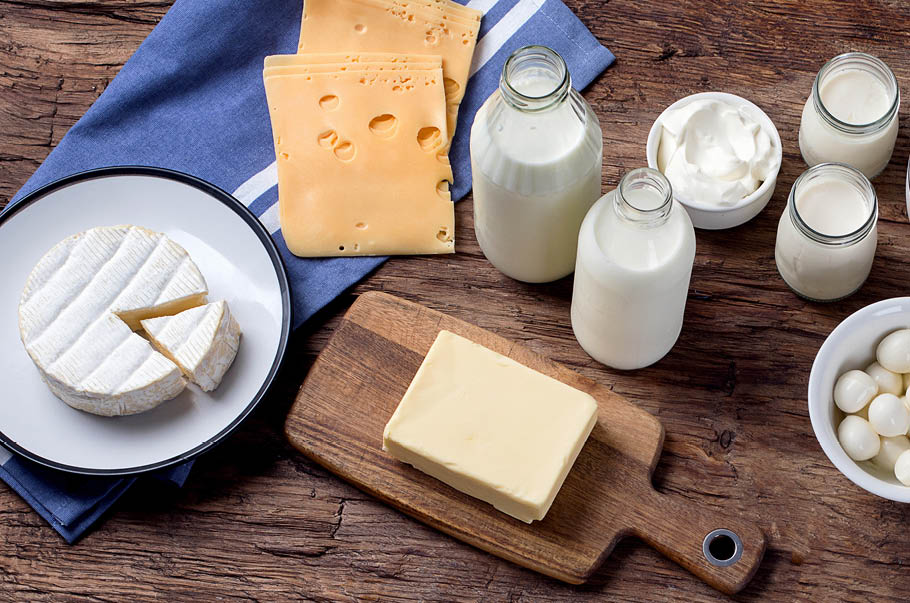The transformation of the Polish dairy industry
The Polish dairy industry underwent a transformation after the accession of Poland to the EU. As a result, farms were modernised and dairy processing was upgraded using EU funds. After the accession, a significant increase in the productivity of Polish dairy farms was recorded, including the increased milk yield of dairy cows. The production of milk and dairy products became concentrated, which translated into economies of scale. Purchasing of milk in Poland after 2005 increased by 3 billion litres, i.e. by 35%, and the average growth rate of milk deliveries in Poland at that time was two times faster than that observed in the EU. The increase in purchasing of milk resulted from the higher demand for raw material from the developing processing industry. In the years 2005-2018, the revenues of companies involved in milk processing rose by 87%. The dairy industry boom also contributed to the development of Polish companies delivering specialised technologies, devices, equipment and means of production at each stage of the production of milk.
Currently, Poland has one of the most modern dairy industries in Europe, and Polish milk processors are among the leading major agri-food companies in Poland. Milk processing in Poland is dominated by cooperatives with majority Polish capital, which acquire raw material directly from farmers whose farms are located mainly in the central-eastern part of the country. This region is characterised by exceptional environmental conditions – a high level of naturalness and the cleanest air in Poland. Polish dairy companies use the best raw material, while focusing on food safety, technological progress and innovation in processing. They offer a wide range of top-quality products at competitive prices, thus creating one of the most valuable brands in the Polish food market. The above-mentioned factors translate into the high production and export results achieved by the Polish dairy industry.
Polish milk tastes good in the West and in the East
The Polish dairy industry generates significant production surpluses, as a consequence of which one third of the dairy products produced in Poland is exported. In 2018, the share of dairy products in the commercial structure of Polish agri-food exports was 8%, while the export value of these products reached the highest level in history at EUR 2.24 billion. Poland is ranked fifth in the EU and thirteenth in the world as a producer of milk, and tenth in the world as an exporter of milk. It also occupies a leading position in the EU as a producer of dairy products – fourth in the EU in the production of skimmed milk powder, fifth with regard to the production of milk, cheese and curd and sixth in the production of fresh dairy products (fresh milk, buttermilk, cream for direct consumption, kefir, etc.). Polish ripened cheeses are enjoying growing popularity; they meet global standards and are appreciated mainly in the Western European countries having rich cheese-making traditions, such as the Netherlands, Italy and Germany. Other Polish export hits include whey and ice cream.
Products exported in 2018 were sent to 86 countries – both to EU consumers (78% of the Polish dairy exports in total) and to non-EU countries. The major customers of Polish dairy products were Germany (23%), the Netherlands (8%) and the Czech Republic (7%). As regards non-EU countries, Polish products went to Algeria, Saudi Arabia and China among others.
The export of dairy products to China is characterised by a high export growth rate. This country is considered as one of the most promising export destinations for Polish agri-food producers. According to the Polish Chamber of Milk, over the last six years, the export of dairy products from Poland to China has increased more than seven times. Milk and cream, uncondensed and with no added sugar, prevail in the commodity structure of Polish agri-food exports to this country. In 2018, sales of these products amounted to 33 thousand tonnes, i.e. 50% more than in 2017. Whey powder is also an export hit. In 2018, China was the second largest customer of Polish whey, right after the Netherlands. Poland exported to China 32 thousand tonnes of whey powder which accounted for about 15% of the entire export volume of that product from Poland. Polish cheeses, mostly processed, and yoghurt have also become increasingly popular in China.
Will another export record be broken?
The results of trade for the first half of 2019 show that the positive trend is being maintained, both in the case of Polish exports of all food products and of dairy products alone.
According to the preliminary data provided by the Polish Ministry of Finance, in the first half of 2019 the export value of agri-food products from Poland was EUR 15.4 billion and increased by 8.5% in relation to the same period in 2018. If this increase is to be maintained also in the second half of 2019, we may expect the export value of Polish food to exceed the EUR 30 billion mark.
In the first half of 2019, 82% of Polish agri-food products were sent to EU countries, whereby the export value of these products to EU countries increased by 7% in relation to the comparable period of 2018. In addition, an increase of 17% was noticed in the export value of these products to other countries, including the United States, which keeps its position as the primary customer of Polish food among the non-EU countries.
The export value of dairy products from Poland in the first half of 2019 was EUR 1,174 million and was more than 2% higher than in the same period of 2018. A significant increase may be observed in the case of Polish milk, cream and ice cream. At the same time, revenues from the export of butter were limited.
Polish dairy products in the first half of 2019 were sent mostly to EU countries. One quarter of Polish exports of these products was exported to non-EU markets, such as China (3% in the geographical structure of export), Algeria (2%) and Saudi Arabia (2%). There was a significant increase in the export of these products to Mexico (a record-breaking increase in value of 3,784% in relation to the comparable period of 2018), Ukraine, Indonesia and Japan. The 30% increase in the export value to China is also significant. In the first half of 2019, the export of dairy products to that country amounted to EUR 34 million. It is worth mentioning that China was the second biggest (after Germany) customer of Polish liquid milk.
The European Commission’s forecasts for the years 2018-2030 point to an increase in the global consumption of fresh and processed dairy products, as well as to an increased demand for traditional dairy products from the EU. What is particularly forecast is an increase in the interest in products with value added, such as organic products, which are included in the products offered by Polish producers. Exports of cheese, whole and skimmed milk powder and whey powder are set to increase by about 330 thousand tonnes (in milk equivalent) per year. All indications are that Polish producers of dairy products may look to the future with reasonable optimism.
The KOWR supports Polish producers from the dairy industry
Even the best products need support with regard to promotion in international markets. The promotion of Polish food and support for Polish agri-food exports are the job of the National Support Centre for Agriculture (KOWR). The tasks of the KOWR include organising economic missions and study visits of companies, facilitating cooperation among Polish and foreign agri-food business operators, organising national stands under the “Poland Tastes Good” banner at international fair events, and more.
The KOWR analyses market conditions so as to give the best response to the needs of the Polish agri-food sector, including the dairy industry. In 2019, the banner carries out activities in 16 international markets. The activities planned for 2020 cover 22 markets and will be carried out in Germany, China, Vietnam and Saudi Arabia among other countries.
If you wish to know more or to enquire about working with us, you are kindly invited to contact us by e-mail eksporter@kowr.gov.pl.
Author: Anna Artemiuk-Błaszkiewicz, Senior Specialist in the Export Support Department of the National Support Centre for Agriculture (KOWR)












